Sustainable Tourism Development in Qatar: Planning and Challenges
VerifiedAdded on 2024/05/29
|27
|5713
|380
Report
AI Summary
This report provides a comprehensive analysis of sustainable tourism development in Qatar. It begins by discussing how stakeholders benefit from tourism development planning, highlighting the economic development, resource allocation, community integration, competitive advantages, and responsible culture fostered by tourism. The report then examines the advantages and disadvantages of public/private sector partnerships in tourism planning, using examples from Qatar. Furthermore, it analyses tourism development planning at international, national, regional, and sub-regional levels, emphasizing the significance of interactive planning systems and processes in addressing issues like environmental damage and congestion. Different methods for measuring tourist impact are evaluated, followed by a justification for introducing sustainability concepts in tourism development. Factors hindering sustainable tourism, stages in planning for sustainability, methods for resolving conflicts of interest, implications of balancing supply and demand, and moral/ethical issues of enclave tourism are also examined. The report concludes with a comparison of tourism development issues in developing countries and emerging destinations, along with recommendations for the future development of tourism in these chosen destinations. This document is available on Desklib, a platform offering study tools for students.
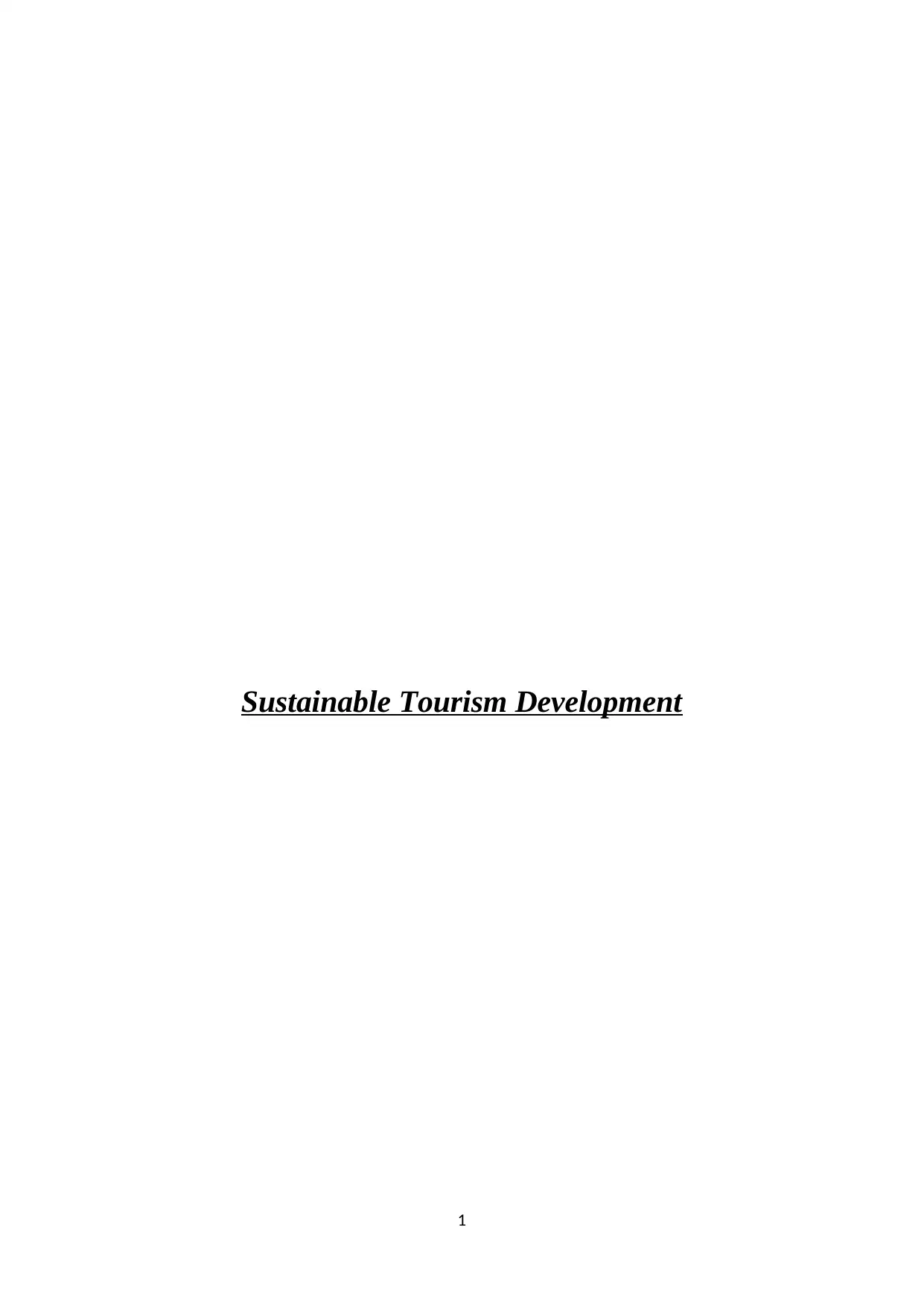
Sustainable Tourism Development
1
1
Paraphrase This Document
Need a fresh take? Get an instant paraphrase of this document with our AI Paraphraser
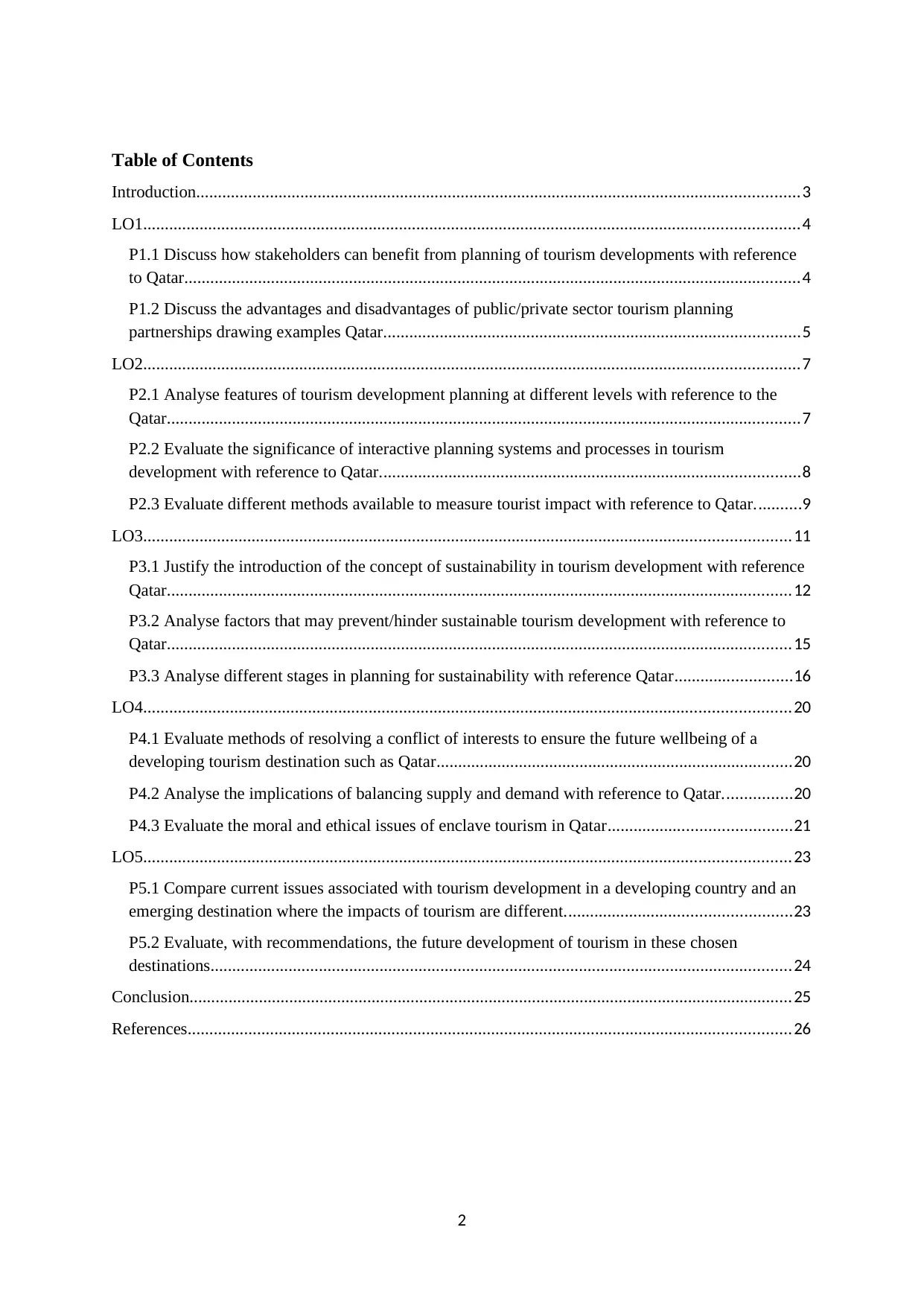
Table of Contents
Introduction...........................................................................................................................................3
LO1.......................................................................................................................................................4
P1.1 Discuss how stakeholders can benefit from planning of tourism developments with reference
to Qatar..............................................................................................................................................4
P1.2 Discuss the advantages and disadvantages of public/private sector tourism planning
partnerships drawing examples Qatar................................................................................................5
LO2.......................................................................................................................................................7
P2.1 Analyse features of tourism development planning at different levels with reference to the
Qatar..................................................................................................................................................7
P2.2 Evaluate the significance of interactive planning systems and processes in tourism
development with reference to Qatar.................................................................................................8
P2.3 Evaluate different methods available to measure tourist impact with reference to Qatar...........9
LO3.....................................................................................................................................................11
P3.1 Justify the introduction of the concept of sustainability in tourism development with reference
Qatar................................................................................................................................................12
P3.2 Analyse factors that may prevent/hinder sustainable tourism development with reference to
Qatar................................................................................................................................................15
P3.3 Analyse different stages in planning for sustainability with reference Qatar...........................16
LO4.....................................................................................................................................................20
P4.1 Evaluate methods of resolving a conflict of interests to ensure the future wellbeing of a
developing tourism destination such as Qatar..................................................................................20
P4.2 Analyse the implications of balancing supply and demand with reference to Qatar................20
P4.3 Evaluate the moral and ethical issues of enclave tourism in Qatar..........................................21
LO5.....................................................................................................................................................23
P5.1 Compare current issues associated with tourism development in a developing country and an
emerging destination where the impacts of tourism are different....................................................23
P5.2 Evaluate, with recommendations, the future development of tourism in these chosen
destinations......................................................................................................................................24
Conclusion...........................................................................................................................................25
References...........................................................................................................................................26
2
Introduction...........................................................................................................................................3
LO1.......................................................................................................................................................4
P1.1 Discuss how stakeholders can benefit from planning of tourism developments with reference
to Qatar..............................................................................................................................................4
P1.2 Discuss the advantages and disadvantages of public/private sector tourism planning
partnerships drawing examples Qatar................................................................................................5
LO2.......................................................................................................................................................7
P2.1 Analyse features of tourism development planning at different levels with reference to the
Qatar..................................................................................................................................................7
P2.2 Evaluate the significance of interactive planning systems and processes in tourism
development with reference to Qatar.................................................................................................8
P2.3 Evaluate different methods available to measure tourist impact with reference to Qatar...........9
LO3.....................................................................................................................................................11
P3.1 Justify the introduction of the concept of sustainability in tourism development with reference
Qatar................................................................................................................................................12
P3.2 Analyse factors that may prevent/hinder sustainable tourism development with reference to
Qatar................................................................................................................................................15
P3.3 Analyse different stages in planning for sustainability with reference Qatar...........................16
LO4.....................................................................................................................................................20
P4.1 Evaluate methods of resolving a conflict of interests to ensure the future wellbeing of a
developing tourism destination such as Qatar..................................................................................20
P4.2 Analyse the implications of balancing supply and demand with reference to Qatar................20
P4.3 Evaluate the moral and ethical issues of enclave tourism in Qatar..........................................21
LO5.....................................................................................................................................................23
P5.1 Compare current issues associated with tourism development in a developing country and an
emerging destination where the impacts of tourism are different....................................................23
P5.2 Evaluate, with recommendations, the future development of tourism in these chosen
destinations......................................................................................................................................24
Conclusion...........................................................................................................................................25
References...........................................................................................................................................26
2
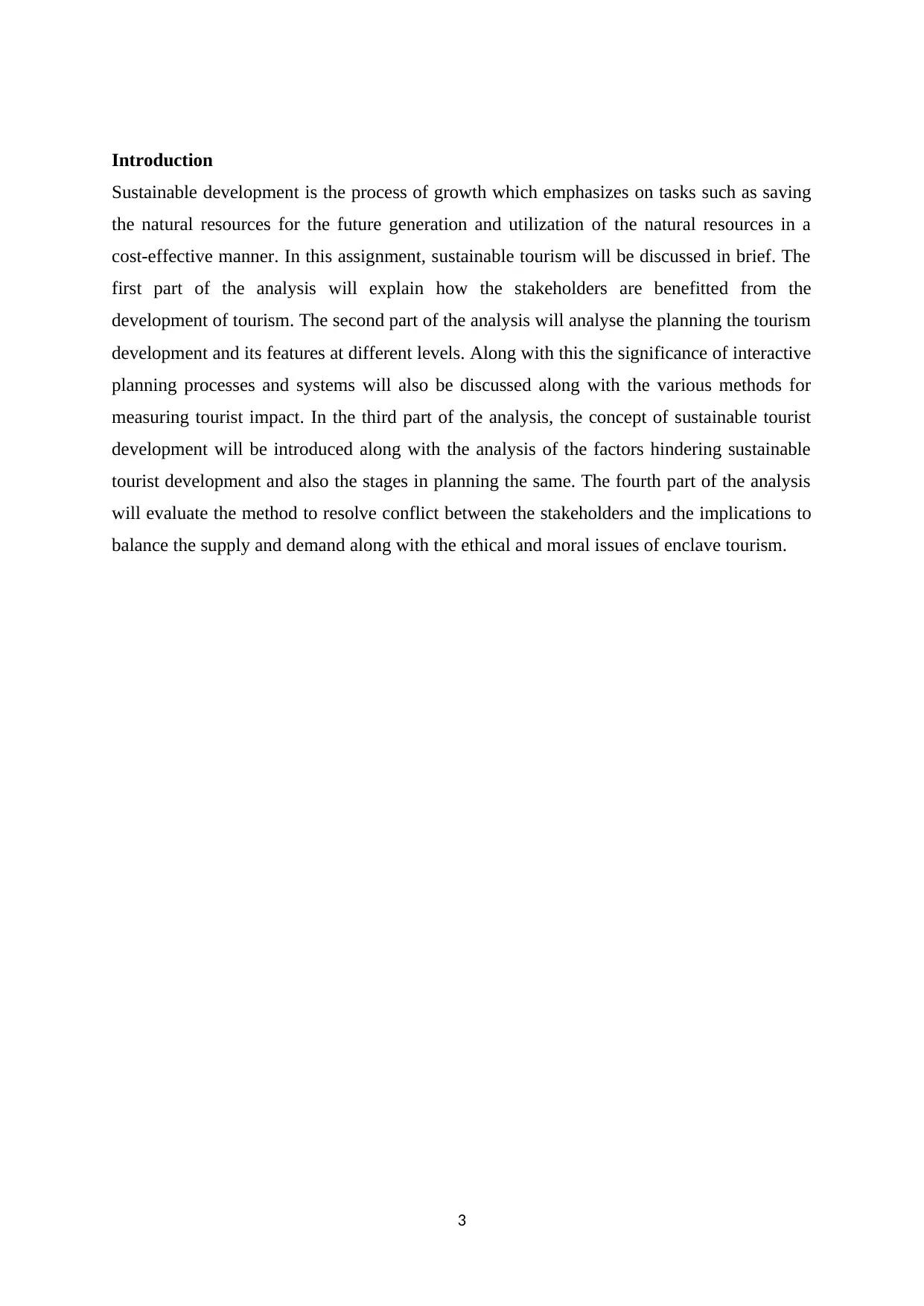
Introduction
Sustainable development is the process of growth which emphasizes on tasks such as saving
the natural resources for the future generation and utilization of the natural resources in a
cost-effective manner. In this assignment, sustainable tourism will be discussed in brief. The
first part of the analysis will explain how the stakeholders are benefitted from the
development of tourism. The second part of the analysis will analyse the planning the tourism
development and its features at different levels. Along with this the significance of interactive
planning processes and systems will also be discussed along with the various methods for
measuring tourist impact. In the third part of the analysis, the concept of sustainable tourist
development will be introduced along with the analysis of the factors hindering sustainable
tourist development and also the stages in planning the same. The fourth part of the analysis
will evaluate the method to resolve conflict between the stakeholders and the implications to
balance the supply and demand along with the ethical and moral issues of enclave tourism.
3
Sustainable development is the process of growth which emphasizes on tasks such as saving
the natural resources for the future generation and utilization of the natural resources in a
cost-effective manner. In this assignment, sustainable tourism will be discussed in brief. The
first part of the analysis will explain how the stakeholders are benefitted from the
development of tourism. The second part of the analysis will analyse the planning the tourism
development and its features at different levels. Along with this the significance of interactive
planning processes and systems will also be discussed along with the various methods for
measuring tourist impact. In the third part of the analysis, the concept of sustainable tourist
development will be introduced along with the analysis of the factors hindering sustainable
tourist development and also the stages in planning the same. The fourth part of the analysis
will evaluate the method to resolve conflict between the stakeholders and the implications to
balance the supply and demand along with the ethical and moral issues of enclave tourism.
3
⊘ This is a preview!⊘
Do you want full access?
Subscribe today to unlock all pages.

Trusted by 1+ million students worldwide
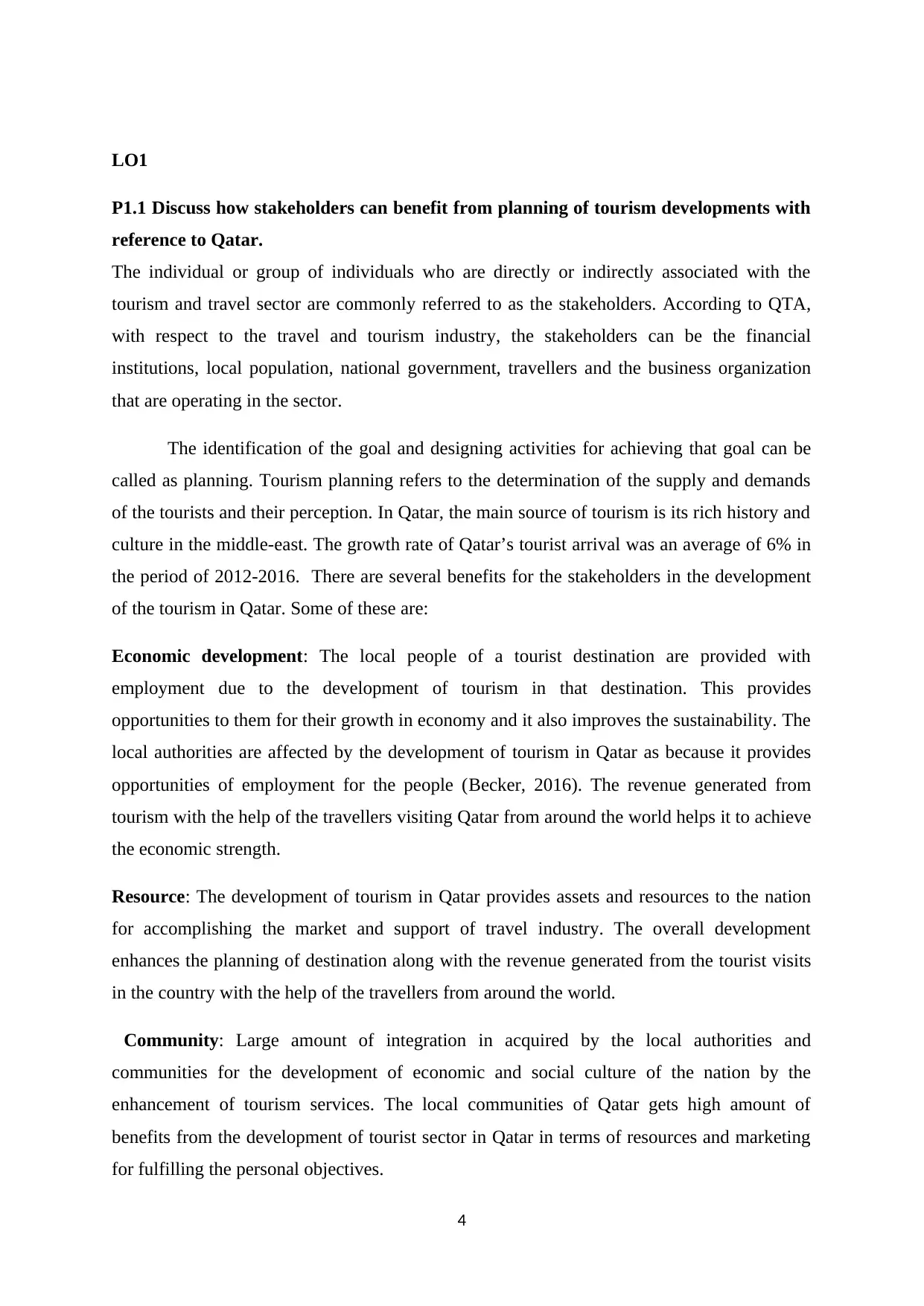
LO1
P1.1 Discuss how stakeholders can benefit from planning of tourism developments with
reference to Qatar.
The individual or group of individuals who are directly or indirectly associated with the
tourism and travel sector are commonly referred to as the stakeholders. According to QTA,
with respect to the travel and tourism industry, the stakeholders can be the financial
institutions, local population, national government, travellers and the business organization
that are operating in the sector.
The identification of the goal and designing activities for achieving that goal can be
called as planning. Tourism planning refers to the determination of the supply and demands
of the tourists and their perception. In Qatar, the main source of tourism is its rich history and
culture in the middle-east. The growth rate of Qatar’s tourist arrival was an average of 6% in
the period of 2012-2016. There are several benefits for the stakeholders in the development
of the tourism in Qatar. Some of these are:
Economic development: The local people of a tourist destination are provided with
employment due to the development of tourism in that destination. This provides
opportunities to them for their growth in economy and it also improves the sustainability. The
local authorities are affected by the development of tourism in Qatar as because it provides
opportunities of employment for the people (Becker, 2016). The revenue generated from
tourism with the help of the travellers visiting Qatar from around the world helps it to achieve
the economic strength.
Resource: The development of tourism in Qatar provides assets and resources to the nation
for accomplishing the market and support of travel industry. The overall development
enhances the planning of destination along with the revenue generated from the tourist visits
in the country with the help of the travellers from around the world.
Community: Large amount of integration in acquired by the local authorities and
communities for the development of economic and social culture of the nation by the
enhancement of tourism services. The local communities of Qatar gets high amount of
benefits from the development of tourist sector in Qatar in terms of resources and marketing
for fulfilling the personal objectives.
4
P1.1 Discuss how stakeholders can benefit from planning of tourism developments with
reference to Qatar.
The individual or group of individuals who are directly or indirectly associated with the
tourism and travel sector are commonly referred to as the stakeholders. According to QTA,
with respect to the travel and tourism industry, the stakeholders can be the financial
institutions, local population, national government, travellers and the business organization
that are operating in the sector.
The identification of the goal and designing activities for achieving that goal can be
called as planning. Tourism planning refers to the determination of the supply and demands
of the tourists and their perception. In Qatar, the main source of tourism is its rich history and
culture in the middle-east. The growth rate of Qatar’s tourist arrival was an average of 6% in
the period of 2012-2016. There are several benefits for the stakeholders in the development
of the tourism in Qatar. Some of these are:
Economic development: The local people of a tourist destination are provided with
employment due to the development of tourism in that destination. This provides
opportunities to them for their growth in economy and it also improves the sustainability. The
local authorities are affected by the development of tourism in Qatar as because it provides
opportunities of employment for the people (Becker, 2016). The revenue generated from
tourism with the help of the travellers visiting Qatar from around the world helps it to achieve
the economic strength.
Resource: The development of tourism in Qatar provides assets and resources to the nation
for accomplishing the market and support of travel industry. The overall development
enhances the planning of destination along with the revenue generated from the tourist visits
in the country with the help of the travellers from around the world.
Community: Large amount of integration in acquired by the local authorities and
communities for the development of economic and social culture of the nation by the
enhancement of tourism services. The local communities of Qatar gets high amount of
benefits from the development of tourist sector in Qatar in terms of resources and marketing
for fulfilling the personal objectives.
4
Paraphrase This Document
Need a fresh take? Get an instant paraphrase of this document with our AI Paraphraser
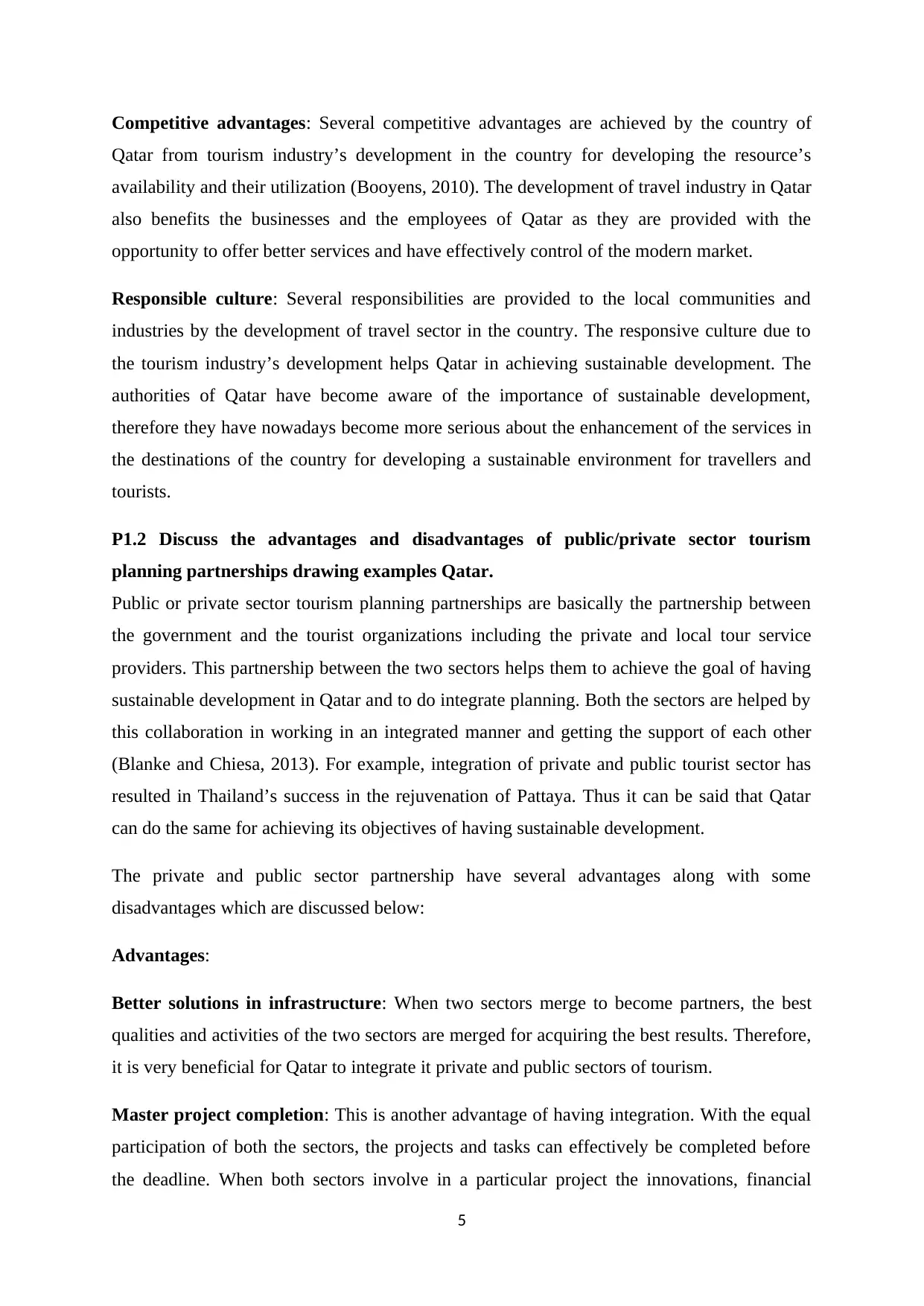
Competitive advantages: Several competitive advantages are achieved by the country of
Qatar from tourism industry’s development in the country for developing the resource’s
availability and their utilization (Booyens, 2010). The development of travel industry in Qatar
also benefits the businesses and the employees of Qatar as they are provided with the
opportunity to offer better services and have effectively control of the modern market.
Responsible culture: Several responsibilities are provided to the local communities and
industries by the development of travel sector in the country. The responsive culture due to
the tourism industry’s development helps Qatar in achieving sustainable development. The
authorities of Qatar have become aware of the importance of sustainable development,
therefore they have nowadays become more serious about the enhancement of the services in
the destinations of the country for developing a sustainable environment for travellers and
tourists.
P1.2 Discuss the advantages and disadvantages of public/private sector tourism
planning partnerships drawing examples Qatar.
Public or private sector tourism planning partnerships are basically the partnership between
the government and the tourist organizations including the private and local tour service
providers. This partnership between the two sectors helps them to achieve the goal of having
sustainable development in Qatar and to do integrate planning. Both the sectors are helped by
this collaboration in working in an integrated manner and getting the support of each other
(Blanke and Chiesa, 2013). For example, integration of private and public tourist sector has
resulted in Thailand’s success in the rejuvenation of Pattaya. Thus it can be said that Qatar
can do the same for achieving its objectives of having sustainable development.
The private and public sector partnership have several advantages along with some
disadvantages which are discussed below:
Advantages:
Better solutions in infrastructure: When two sectors merge to become partners, the best
qualities and activities of the two sectors are merged for acquiring the best results. Therefore,
it is very beneficial for Qatar to integrate it private and public sectors of tourism.
Master project completion: This is another advantage of having integration. With the equal
participation of both the sectors, the projects and tasks can effectively be completed before
the deadline. When both sectors involve in a particular project the innovations, financial
5
Qatar from tourism industry’s development in the country for developing the resource’s
availability and their utilization (Booyens, 2010). The development of travel industry in Qatar
also benefits the businesses and the employees of Qatar as they are provided with the
opportunity to offer better services and have effectively control of the modern market.
Responsible culture: Several responsibilities are provided to the local communities and
industries by the development of travel sector in the country. The responsive culture due to
the tourism industry’s development helps Qatar in achieving sustainable development. The
authorities of Qatar have become aware of the importance of sustainable development,
therefore they have nowadays become more serious about the enhancement of the services in
the destinations of the country for developing a sustainable environment for travellers and
tourists.
P1.2 Discuss the advantages and disadvantages of public/private sector tourism
planning partnerships drawing examples Qatar.
Public or private sector tourism planning partnerships are basically the partnership between
the government and the tourist organizations including the private and local tour service
providers. This partnership between the two sectors helps them to achieve the goal of having
sustainable development in Qatar and to do integrate planning. Both the sectors are helped by
this collaboration in working in an integrated manner and getting the support of each other
(Blanke and Chiesa, 2013). For example, integration of private and public tourist sector has
resulted in Thailand’s success in the rejuvenation of Pattaya. Thus it can be said that Qatar
can do the same for achieving its objectives of having sustainable development.
The private and public sector partnership have several advantages along with some
disadvantages which are discussed below:
Advantages:
Better solutions in infrastructure: When two sectors merge to become partners, the best
qualities and activities of the two sectors are merged for acquiring the best results. Therefore,
it is very beneficial for Qatar to integrate it private and public sectors of tourism.
Master project completion: This is another advantage of having integration. With the equal
participation of both the sectors, the projects and tasks can effectively be completed before
the deadline. When both sectors involve in a particular project the innovations, financial
5
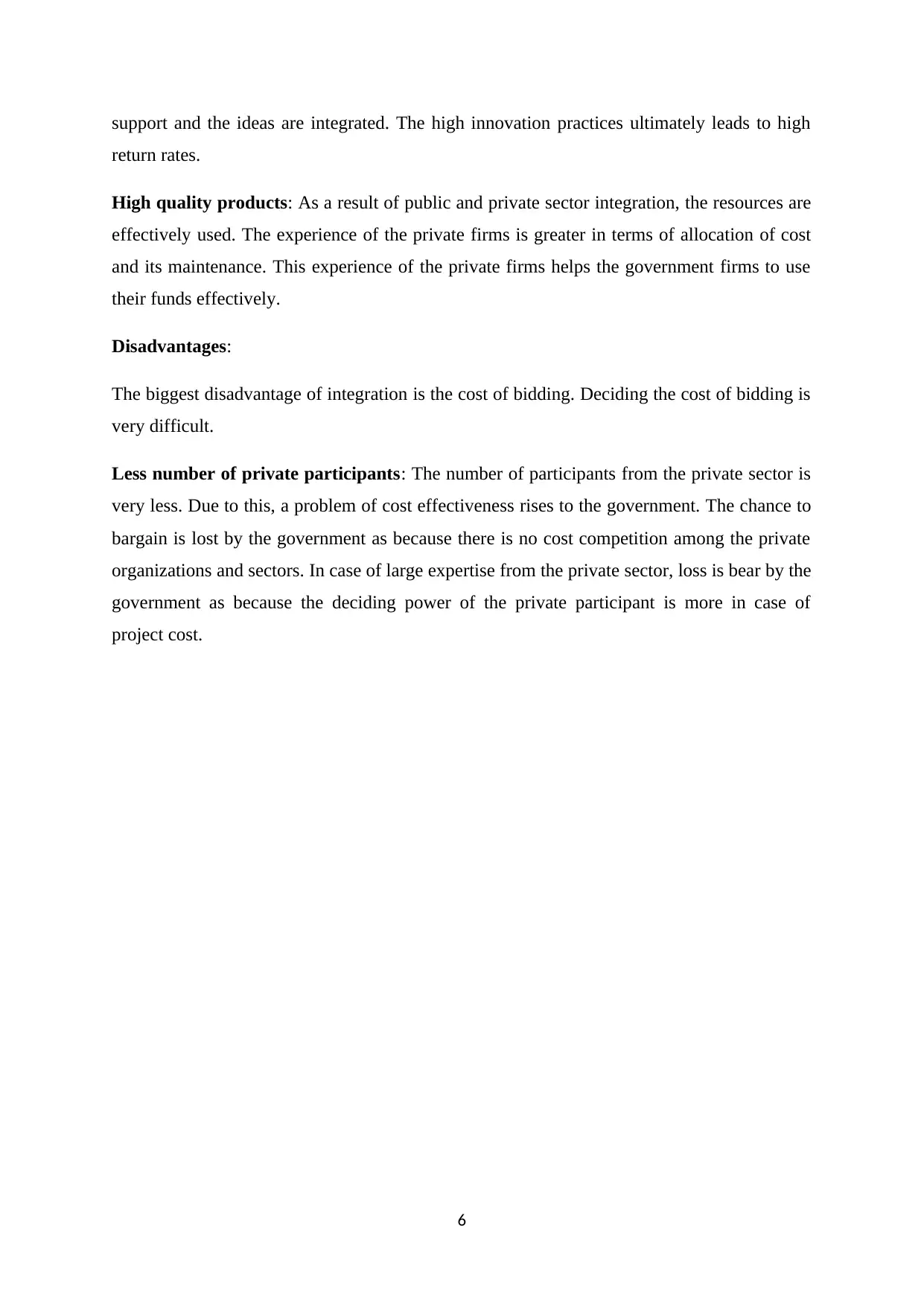
support and the ideas are integrated. The high innovation practices ultimately leads to high
return rates.
High quality products: As a result of public and private sector integration, the resources are
effectively used. The experience of the private firms is greater in terms of allocation of cost
and its maintenance. This experience of the private firms helps the government firms to use
their funds effectively.
Disadvantages:
The biggest disadvantage of integration is the cost of bidding. Deciding the cost of bidding is
very difficult.
Less number of private participants: The number of participants from the private sector is
very less. Due to this, a problem of cost effectiveness rises to the government. The chance to
bargain is lost by the government as because there is no cost competition among the private
organizations and sectors. In case of large expertise from the private sector, loss is bear by the
government as because the deciding power of the private participant is more in case of
project cost.
6
return rates.
High quality products: As a result of public and private sector integration, the resources are
effectively used. The experience of the private firms is greater in terms of allocation of cost
and its maintenance. This experience of the private firms helps the government firms to use
their funds effectively.
Disadvantages:
The biggest disadvantage of integration is the cost of bidding. Deciding the cost of bidding is
very difficult.
Less number of private participants: The number of participants from the private sector is
very less. Due to this, a problem of cost effectiveness rises to the government. The chance to
bargain is lost by the government as because there is no cost competition among the private
organizations and sectors. In case of large expertise from the private sector, loss is bear by the
government as because the deciding power of the private participant is more in case of
project cost.
6
⊘ This is a preview!⊘
Do you want full access?
Subscribe today to unlock all pages.

Trusted by 1+ million students worldwide
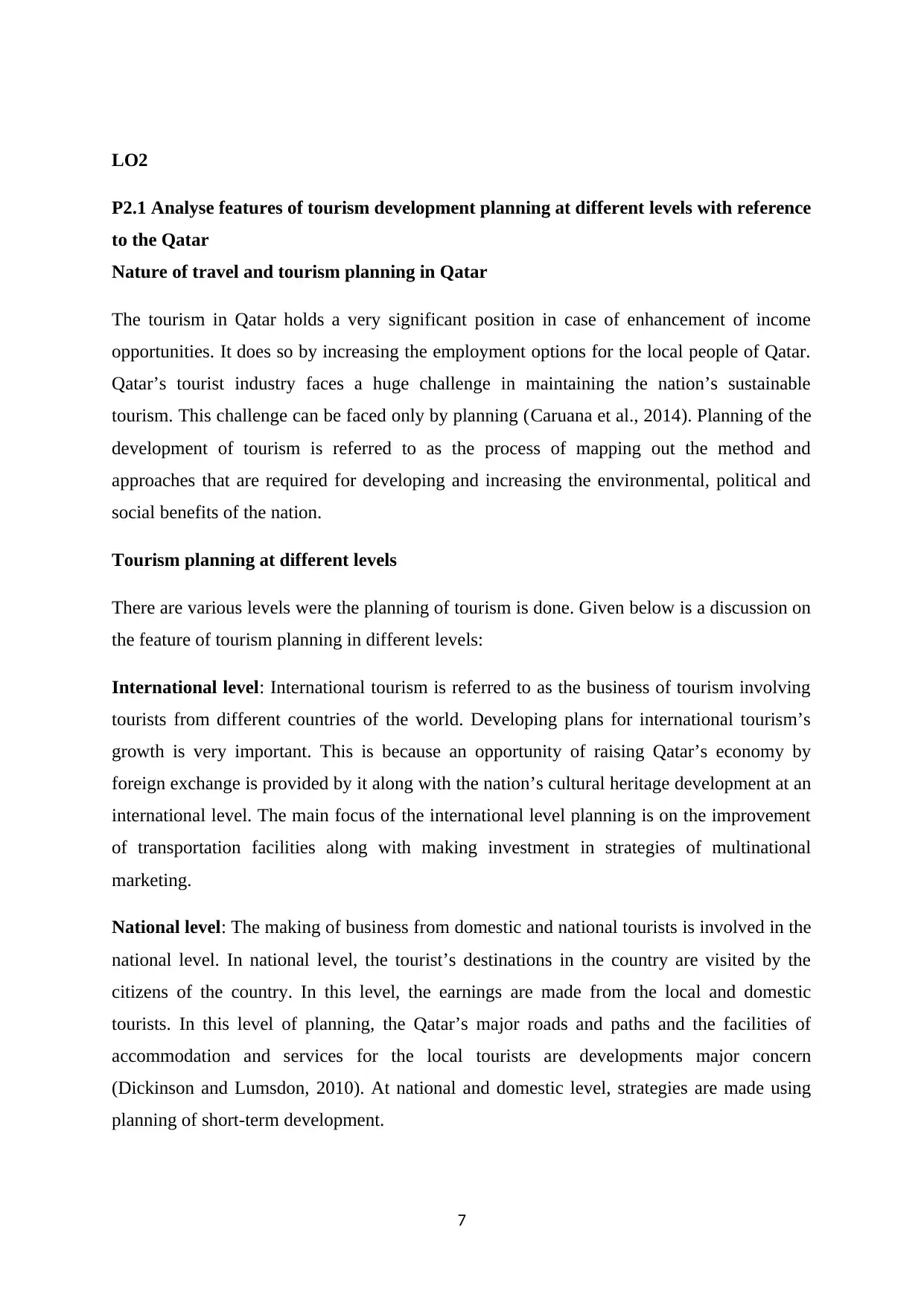
LO2
P2.1 Analyse features of tourism development planning at different levels with reference
to the Qatar
Nature of travel and tourism planning in Qatar
The tourism in Qatar holds a very significant position in case of enhancement of income
opportunities. It does so by increasing the employment options for the local people of Qatar.
Qatar’s tourist industry faces a huge challenge in maintaining the nation’s sustainable
tourism. This challenge can be faced only by planning (Caruana et al., 2014). Planning of the
development of tourism is referred to as the process of mapping out the method and
approaches that are required for developing and increasing the environmental, political and
social benefits of the nation.
Tourism planning at different levels
There are various levels were the planning of tourism is done. Given below is a discussion on
the feature of tourism planning in different levels:
International level: International tourism is referred to as the business of tourism involving
tourists from different countries of the world. Developing plans for international tourism’s
growth is very important. This is because an opportunity of raising Qatar’s economy by
foreign exchange is provided by it along with the nation’s cultural heritage development at an
international level. The main focus of the international level planning is on the improvement
of transportation facilities along with making investment in strategies of multinational
marketing.
National level: The making of business from domestic and national tourists is involved in the
national level. In national level, the tourist’s destinations in the country are visited by the
citizens of the country. In this level, the earnings are made from the local and domestic
tourists. In this level of planning, the Qatar’s major roads and paths and the facilities of
accommodation and services for the local tourists are developments major concern
(Dickinson and Lumsdon, 2010). At national and domestic level, strategies are made using
planning of short-term development.
7
P2.1 Analyse features of tourism development planning at different levels with reference
to the Qatar
Nature of travel and tourism planning in Qatar
The tourism in Qatar holds a very significant position in case of enhancement of income
opportunities. It does so by increasing the employment options for the local people of Qatar.
Qatar’s tourist industry faces a huge challenge in maintaining the nation’s sustainable
tourism. This challenge can be faced only by planning (Caruana et al., 2014). Planning of the
development of tourism is referred to as the process of mapping out the method and
approaches that are required for developing and increasing the environmental, political and
social benefits of the nation.
Tourism planning at different levels
There are various levels were the planning of tourism is done. Given below is a discussion on
the feature of tourism planning in different levels:
International level: International tourism is referred to as the business of tourism involving
tourists from different countries of the world. Developing plans for international tourism’s
growth is very important. This is because an opportunity of raising Qatar’s economy by
foreign exchange is provided by it along with the nation’s cultural heritage development at an
international level. The main focus of the international level planning is on the improvement
of transportation facilities along with making investment in strategies of multinational
marketing.
National level: The making of business from domestic and national tourists is involved in the
national level. In national level, the tourist’s destinations in the country are visited by the
citizens of the country. In this level, the earnings are made from the local and domestic
tourists. In this level of planning, the Qatar’s major roads and paths and the facilities of
accommodation and services for the local tourists are developments major concern
(Dickinson and Lumsdon, 2010). At national and domestic level, strategies are made using
planning of short-term development.
7
Paraphrase This Document
Need a fresh take? Get an instant paraphrase of this document with our AI Paraphraser
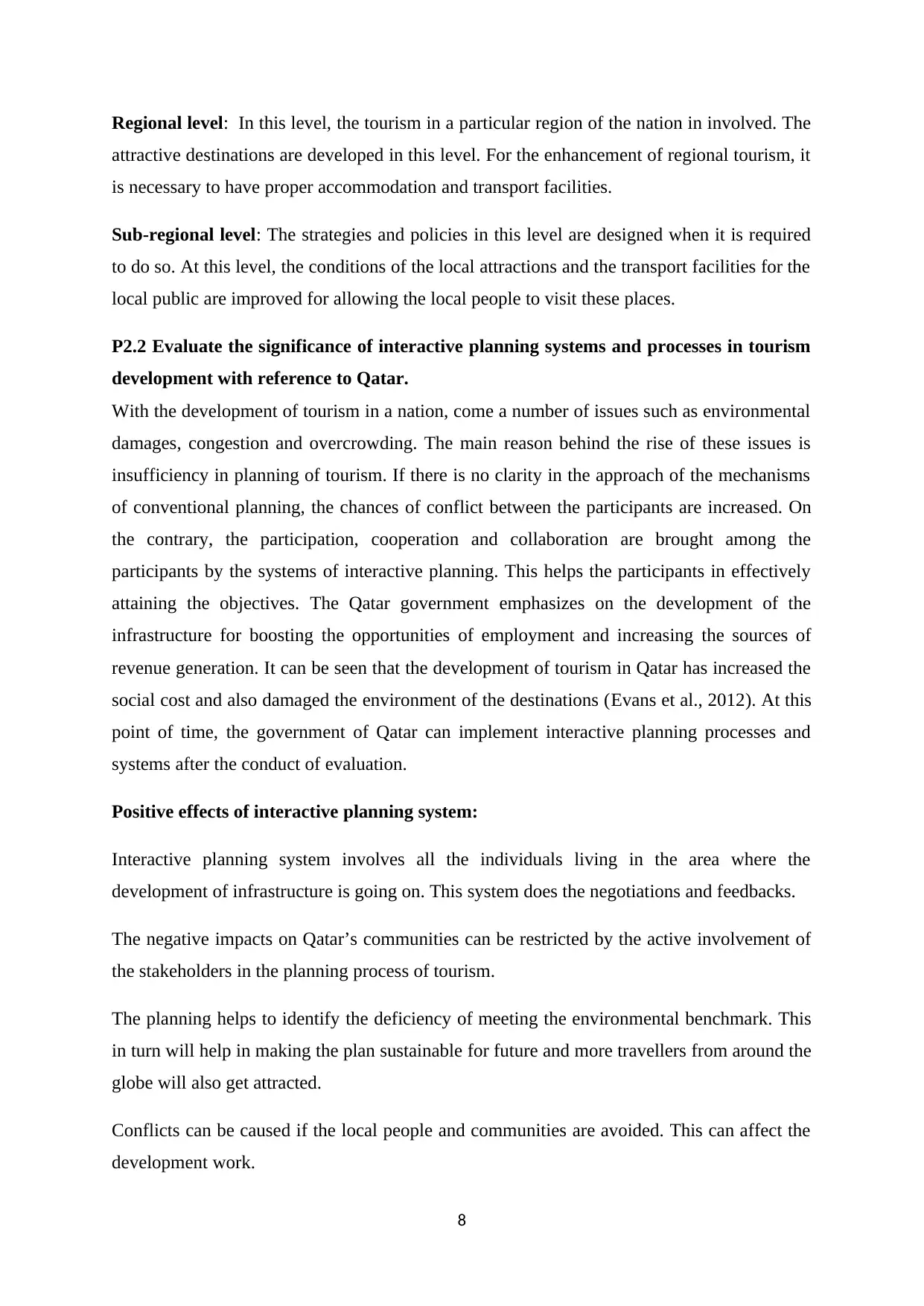
Regional level: In this level, the tourism in a particular region of the nation in involved. The
attractive destinations are developed in this level. For the enhancement of regional tourism, it
is necessary to have proper accommodation and transport facilities.
Sub-regional level: The strategies and policies in this level are designed when it is required
to do so. At this level, the conditions of the local attractions and the transport facilities for the
local public are improved for allowing the local people to visit these places.
P2.2 Evaluate the significance of interactive planning systems and processes in tourism
development with reference to Qatar.
With the development of tourism in a nation, come a number of issues such as environmental
damages, congestion and overcrowding. The main reason behind the rise of these issues is
insufficiency in planning of tourism. If there is no clarity in the approach of the mechanisms
of conventional planning, the chances of conflict between the participants are increased. On
the contrary, the participation, cooperation and collaboration are brought among the
participants by the systems of interactive planning. This helps the participants in effectively
attaining the objectives. The Qatar government emphasizes on the development of the
infrastructure for boosting the opportunities of employment and increasing the sources of
revenue generation. It can be seen that the development of tourism in Qatar has increased the
social cost and also damaged the environment of the destinations (Evans et al., 2012). At this
point of time, the government of Qatar can implement interactive planning processes and
systems after the conduct of evaluation.
Positive effects of interactive planning system:
Interactive planning system involves all the individuals living in the area where the
development of infrastructure is going on. This system does the negotiations and feedbacks.
The negative impacts on Qatar’s communities can be restricted by the active involvement of
the stakeholders in the planning process of tourism.
The planning helps to identify the deficiency of meeting the environmental benchmark. This
in turn will help in making the plan sustainable for future and more travellers from around the
globe will also get attracted.
Conflicts can be caused if the local people and communities are avoided. This can affect the
development work.
8
attractive destinations are developed in this level. For the enhancement of regional tourism, it
is necessary to have proper accommodation and transport facilities.
Sub-regional level: The strategies and policies in this level are designed when it is required
to do so. At this level, the conditions of the local attractions and the transport facilities for the
local public are improved for allowing the local people to visit these places.
P2.2 Evaluate the significance of interactive planning systems and processes in tourism
development with reference to Qatar.
With the development of tourism in a nation, come a number of issues such as environmental
damages, congestion and overcrowding. The main reason behind the rise of these issues is
insufficiency in planning of tourism. If there is no clarity in the approach of the mechanisms
of conventional planning, the chances of conflict between the participants are increased. On
the contrary, the participation, cooperation and collaboration are brought among the
participants by the systems of interactive planning. This helps the participants in effectively
attaining the objectives. The Qatar government emphasizes on the development of the
infrastructure for boosting the opportunities of employment and increasing the sources of
revenue generation. It can be seen that the development of tourism in Qatar has increased the
social cost and also damaged the environment of the destinations (Evans et al., 2012). At this
point of time, the government of Qatar can implement interactive planning processes and
systems after the conduct of evaluation.
Positive effects of interactive planning system:
Interactive planning system involves all the individuals living in the area where the
development of infrastructure is going on. This system does the negotiations and feedbacks.
The negative impacts on Qatar’s communities can be restricted by the active involvement of
the stakeholders in the planning process of tourism.
The planning helps to identify the deficiency of meeting the environmental benchmark. This
in turn will help in making the plan sustainable for future and more travellers from around the
globe will also get attracted.
Conflicts can be caused if the local people and communities are avoided. This can affect the
development work.
8
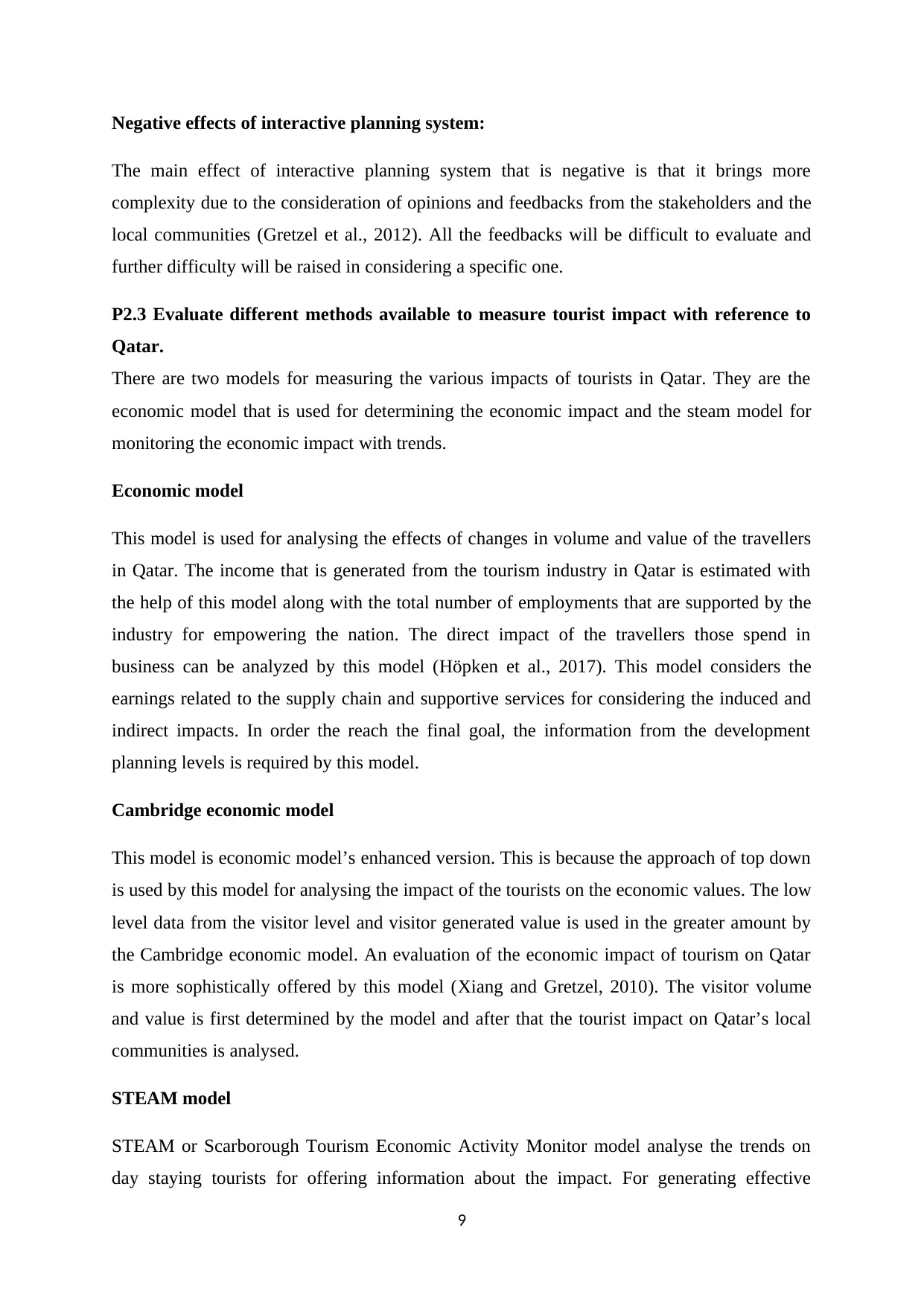
Negative effects of interactive planning system:
The main effect of interactive planning system that is negative is that it brings more
complexity due to the consideration of opinions and feedbacks from the stakeholders and the
local communities (Gretzel et al., 2012). All the feedbacks will be difficult to evaluate and
further difficulty will be raised in considering a specific one.
P2.3 Evaluate different methods available to measure tourist impact with reference to
Qatar.
There are two models for measuring the various impacts of tourists in Qatar. They are the
economic model that is used for determining the economic impact and the steam model for
monitoring the economic impact with trends.
Economic model
This model is used for analysing the effects of changes in volume and value of the travellers
in Qatar. The income that is generated from the tourism industry in Qatar is estimated with
the help of this model along with the total number of employments that are supported by the
industry for empowering the nation. The direct impact of the travellers those spend in
business can be analyzed by this model (Höpken et al., 2017). This model considers the
earnings related to the supply chain and supportive services for considering the induced and
indirect impacts. In order the reach the final goal, the information from the development
planning levels is required by this model.
Cambridge economic model
This model is economic model’s enhanced version. This is because the approach of top down
is used by this model for analysing the impact of the tourists on the economic values. The low
level data from the visitor level and visitor generated value is used in the greater amount by
the Cambridge economic model. An evaluation of the economic impact of tourism on Qatar
is more sophistically offered by this model (Xiang and Gretzel, 2010). The visitor volume
and value is first determined by the model and after that the tourist impact on Qatar’s local
communities is analysed.
STEAM model
STEAM or Scarborough Tourism Economic Activity Monitor model analyse the trends on
day staying tourists for offering information about the impact. For generating effective
9
The main effect of interactive planning system that is negative is that it brings more
complexity due to the consideration of opinions and feedbacks from the stakeholders and the
local communities (Gretzel et al., 2012). All the feedbacks will be difficult to evaluate and
further difficulty will be raised in considering a specific one.
P2.3 Evaluate different methods available to measure tourist impact with reference to
Qatar.
There are two models for measuring the various impacts of tourists in Qatar. They are the
economic model that is used for determining the economic impact and the steam model for
monitoring the economic impact with trends.
Economic model
This model is used for analysing the effects of changes in volume and value of the travellers
in Qatar. The income that is generated from the tourism industry in Qatar is estimated with
the help of this model along with the total number of employments that are supported by the
industry for empowering the nation. The direct impact of the travellers those spend in
business can be analyzed by this model (Höpken et al., 2017). This model considers the
earnings related to the supply chain and supportive services for considering the induced and
indirect impacts. In order the reach the final goal, the information from the development
planning levels is required by this model.
Cambridge economic model
This model is economic model’s enhanced version. This is because the approach of top down
is used by this model for analysing the impact of the tourists on the economic values. The low
level data from the visitor level and visitor generated value is used in the greater amount by
the Cambridge economic model. An evaluation of the economic impact of tourism on Qatar
is more sophistically offered by this model (Xiang and Gretzel, 2010). The visitor volume
and value is first determined by the model and after that the tourist impact on Qatar’s local
communities is analysed.
STEAM model
STEAM or Scarborough Tourism Economic Activity Monitor model analyse the trends on
day staying tourists for offering information about the impact. For generating effective
9
⊘ This is a preview!⊘
Do you want full access?
Subscribe today to unlock all pages.

Trusted by 1+ million students worldwide
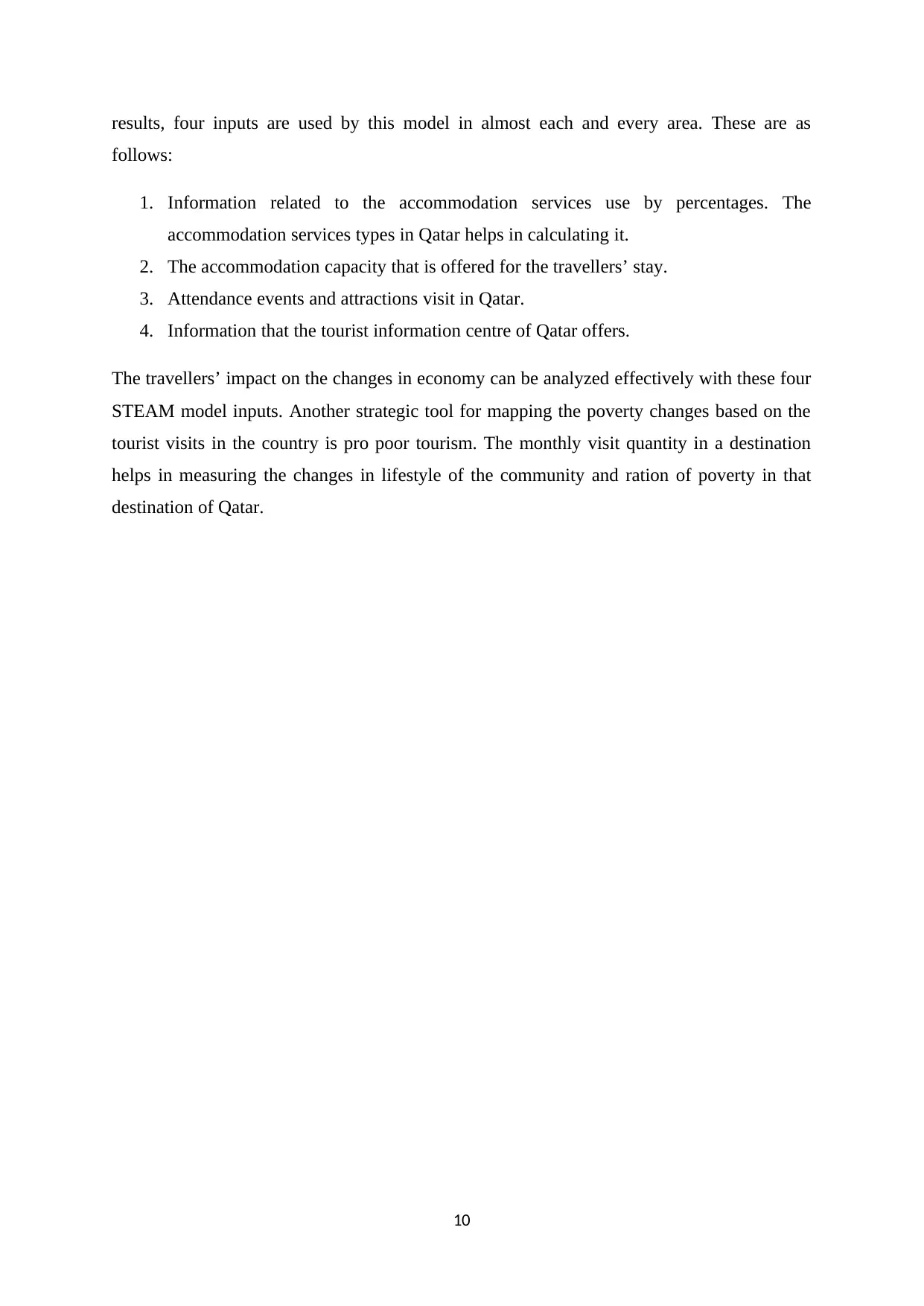
results, four inputs are used by this model in almost each and every area. These are as
follows:
1. Information related to the accommodation services use by percentages. The
accommodation services types in Qatar helps in calculating it.
2. The accommodation capacity that is offered for the travellers’ stay.
3. Attendance events and attractions visit in Qatar.
4. Information that the tourist information centre of Qatar offers.
The travellers’ impact on the changes in economy can be analyzed effectively with these four
STEAM model inputs. Another strategic tool for mapping the poverty changes based on the
tourist visits in the country is pro poor tourism. The monthly visit quantity in a destination
helps in measuring the changes in lifestyle of the community and ration of poverty in that
destination of Qatar.
10
follows:
1. Information related to the accommodation services use by percentages. The
accommodation services types in Qatar helps in calculating it.
2. The accommodation capacity that is offered for the travellers’ stay.
3. Attendance events and attractions visit in Qatar.
4. Information that the tourist information centre of Qatar offers.
The travellers’ impact on the changes in economy can be analyzed effectively with these four
STEAM model inputs. Another strategic tool for mapping the poverty changes based on the
tourist visits in the country is pro poor tourism. The monthly visit quantity in a destination
helps in measuring the changes in lifestyle of the community and ration of poverty in that
destination of Qatar.
10
Paraphrase This Document
Need a fresh take? Get an instant paraphrase of this document with our AI Paraphraser
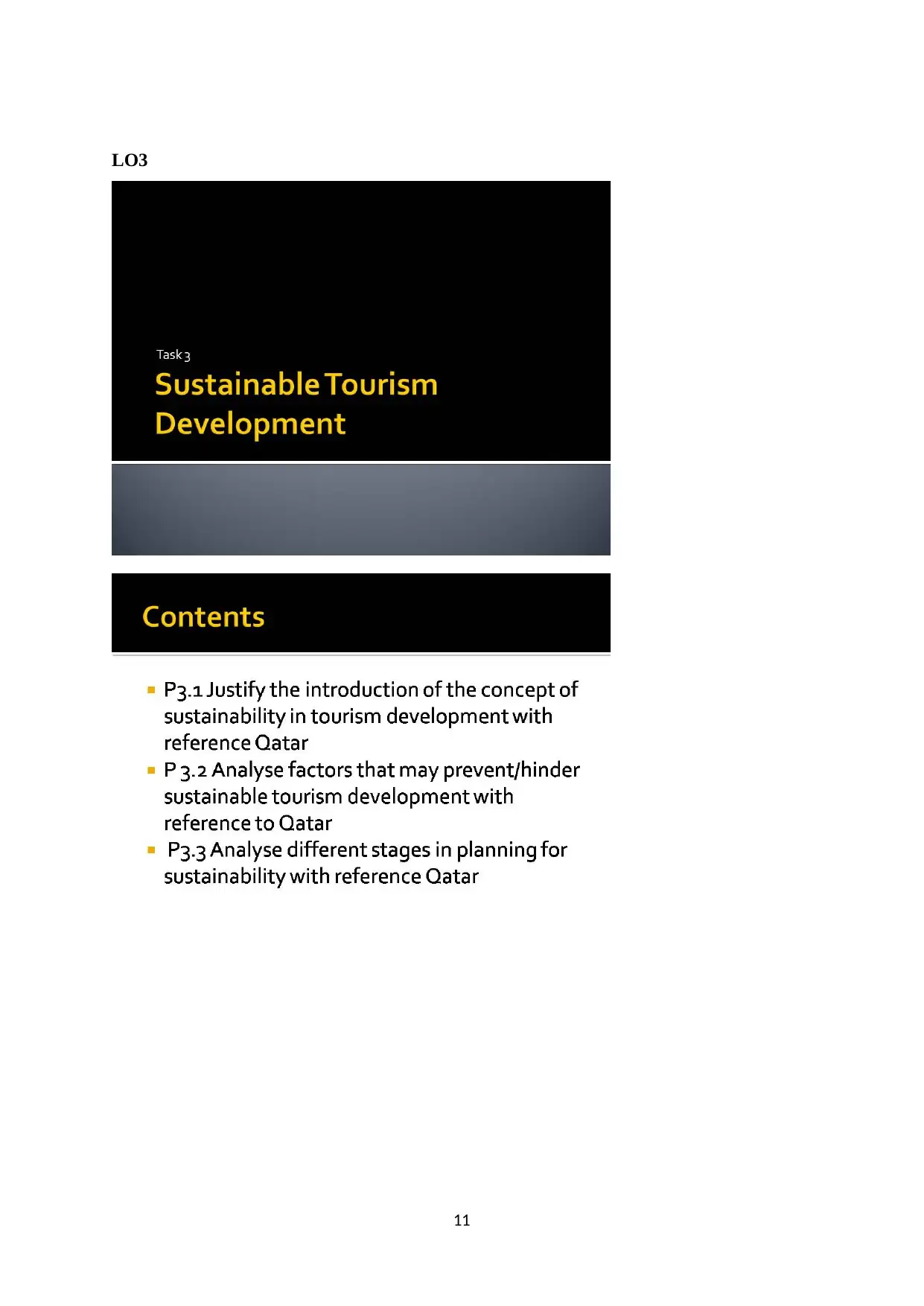
LO3
11
11
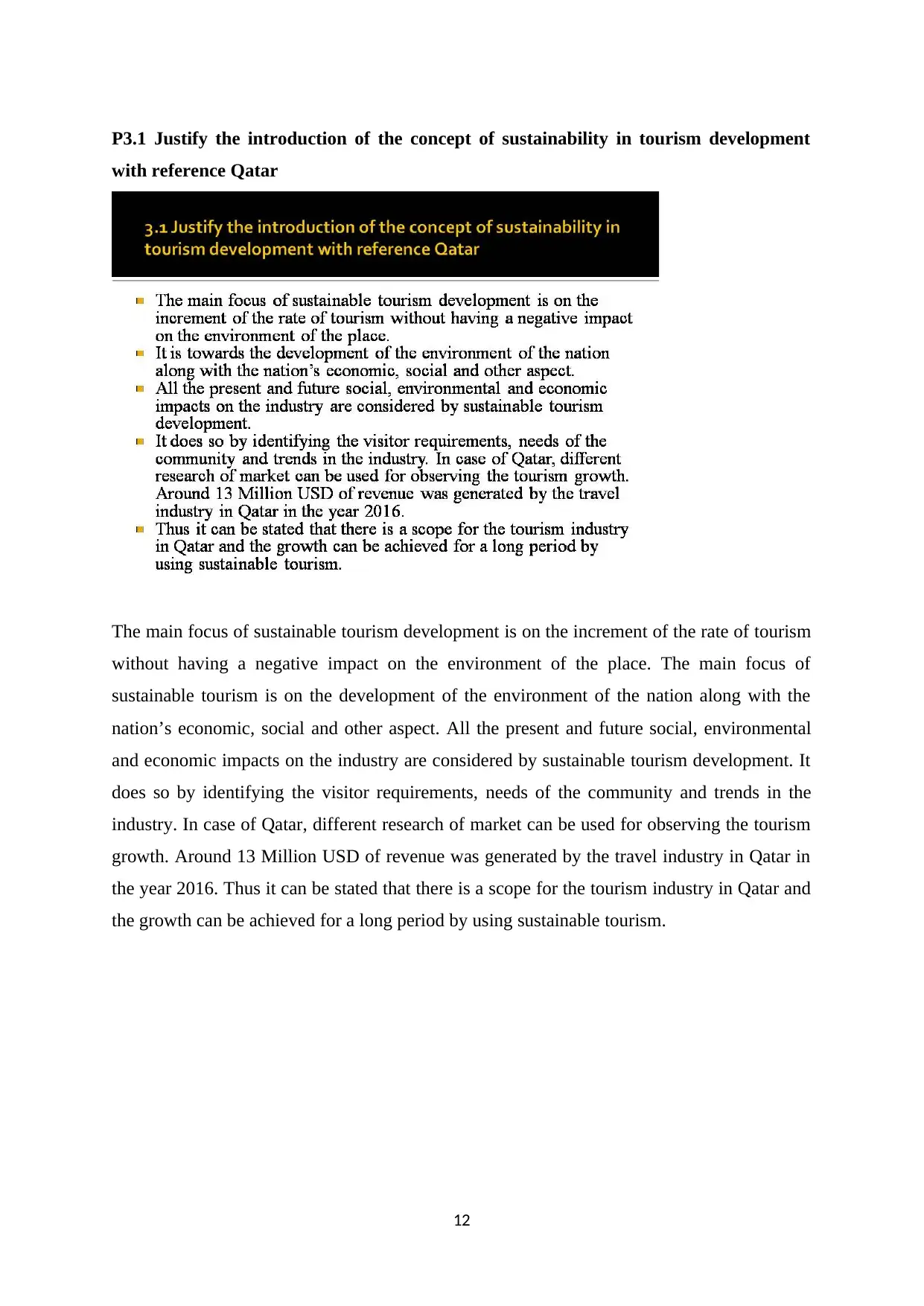
P3.1 Justify the introduction of the concept of sustainability in tourism development
with reference Qatar
The main focus of sustainable tourism development is on the increment of the rate of tourism
without having a negative impact on the environment of the place. The main focus of
sustainable tourism is on the development of the environment of the nation along with the
nation’s economic, social and other aspect. All the present and future social, environmental
and economic impacts on the industry are considered by sustainable tourism development. It
does so by identifying the visitor requirements, needs of the community and trends in the
industry. In case of Qatar, different research of market can be used for observing the tourism
growth. Around 13 Million USD of revenue was generated by the travel industry in Qatar in
the year 2016. Thus it can be stated that there is a scope for the tourism industry in Qatar and
the growth can be achieved for a long period by using sustainable tourism.
12
with reference Qatar
The main focus of sustainable tourism development is on the increment of the rate of tourism
without having a negative impact on the environment of the place. The main focus of
sustainable tourism is on the development of the environment of the nation along with the
nation’s economic, social and other aspect. All the present and future social, environmental
and economic impacts on the industry are considered by sustainable tourism development. It
does so by identifying the visitor requirements, needs of the community and trends in the
industry. In case of Qatar, different research of market can be used for observing the tourism
growth. Around 13 Million USD of revenue was generated by the travel industry in Qatar in
the year 2016. Thus it can be stated that there is a scope for the tourism industry in Qatar and
the growth can be achieved for a long period by using sustainable tourism.
12
⊘ This is a preview!⊘
Do you want full access?
Subscribe today to unlock all pages.

Trusted by 1+ million students worldwide
1 out of 27
Related Documents
Your All-in-One AI-Powered Toolkit for Academic Success.
+13062052269
info@desklib.com
Available 24*7 on WhatsApp / Email
![[object Object]](/_next/static/media/star-bottom.7253800d.svg)
Unlock your academic potential
Copyright © 2020–2025 A2Z Services. All Rights Reserved. Developed and managed by ZUCOL.


